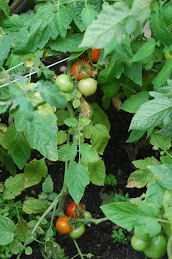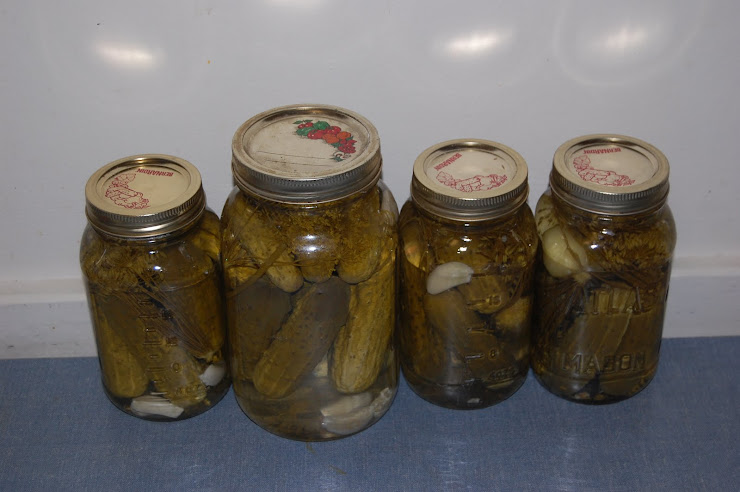
Of all the harbingers of spring, my favourite has to be wild violets. While the flowers
 may be small and delicate, they have the ability to grow just about anywhere and pop up in the most unlikely of places. Their prolific nature makes some people consider them invasive and they do have a tendency to reproduce like crazy but I consider this part of their charm. The most common colour is its namesake purple, some times called the common blue violet, but white violets also grow in abundance here in Ontario. Other colours are less common but can be found occasionally. I spotted this magenta version growing wild in a farmer's field in Niagara region a few years ago and brought some home. It currently has a prominent place in my perennial garden and I have brought it with me through several moves. My most recent find, seen below, has cream coloured petals that deepen to gold in the centre and a purplish throat.
may be small and delicate, they have the ability to grow just about anywhere and pop up in the most unlikely of places. Their prolific nature makes some people consider them invasive and they do have a tendency to reproduce like crazy but I consider this part of their charm. The most common colour is its namesake purple, some times called the common blue violet, but white violets also grow in abundance here in Ontario. Other colours are less common but can be found occasionally. I spotted this magenta version growing wild in a farmer's field in Niagara region a few years ago and brought some home. It currently has a prominent place in my perennial garden and I have brought it with me through several moves. My most recent find, seen below, has cream coloured petals that deepen to gold in the centre and a purplish throat.
 In Victorian times purple violets were considered a symbol of faithfulness and constancy, white violets indicated modesty and yellow violets represented a sense of modest worth. Violets were once commonly used to make perfumes; they are also edible and can be eaten fresh, or used to make syrup, as well as candied violets which are are still a popular as a garnish today. But until recently I was unaware they can be used to make jelly!
In Victorian times purple violets were considered a symbol of faithfulness and constancy, white violets indicated modesty and yellow violets represented a sense of modest worth. Violets were once commonly used to make perfumes; they are also edible and can be eaten fresh, or used to make syrup, as well as candied violets which are are still a popular as a garnish today. But until recently I was unaware they can be used to make jelly!
The CanJam challenge for this month was herbs and frankly I was at a bit of loss. My herb garden is just beginning to show signs of life and although most herbs are readily available year round in the grocery store (and I even have a lovely rosemary plant that overwintered inside,) none of them really say spring for me. When Tigress did a post clarifying the terms of this month's challenge she mentioned that "herbs are generally considered the leafy green parts of a plant (I would include flowers in here too)" and a little bell went off in my head. My first thought was for dandelions and I went scrambling for jelly recipes that use them as a key ingredient. I stumbled onto this gorgeous website http://www.prairielandherbs.com/ and there along with dandelions was a recipe for violet jelly! This alone was enough to make me excited but when I saw the vibrant colour of the jelly they makes I knew we had to try it. The only problem was the violets. Or lack there of. Even with our early spring and unseasonably warm weather I hadn't seen any flowering at the beginning of April. Even dandelions flowers were
 sparse, except of course on the side of the road or in toxic wastelands- ick! So we decided to play the waiting game and hope for the best. I knew we'd have dandelion flowers in time for sure and the recipes were identical. Luckily the violets cooperated and the day before we had scheduled our canning session I discovered a large number blooming on some lawns nearby where I was working. I'm sure more than one person wondered what the crazy woman in the yellow rain slicker was picking- camouflaged I was not!
sparse, except of course on the side of the road or in toxic wastelands- ick! So we decided to play the waiting game and hope for the best. I knew we'd have dandelion flowers in time for sure and the recipes were identical. Luckily the violets cooperated and the day before we had scheduled our canning session I discovered a large number blooming on some lawns nearby where I was working. I'm sure more than one person wondered what the crazy woman in the yellow rain slicker was picking- camouflaged I was not!
Wild Violet Jelly
2 heaping cups of fresh violet petals (see note below)
2 C boiling water
1/4 C well-strained, clear lemon juice
4 C sugar
3 oz liquid pectin (Certo)
NOTE: Look for fully opened flowers, not partially opened buds, for better
Wash petals well, drain and place in heat-proof glass or nonreactive bowl.
Pour boiling water over petals and let steep from 30 minutes to 24 hours. It usually takes about two hours for violets. Strain through a fine sieve, reserving the clear, purplish liquid or infusion. If not using immediately, refrigerate up to 24 hours.
To make the jelly, stir lemon juice and sugar into reserved infusion in  a two-quart nonreactive or stainless steel pan. Bring to a full rolling boil that cannot be stirred down. Add the liquid pectin and continue to boil two minutes, skimming any foam that may rise to the surface.
a two-quart nonreactive or stainless steel pan. Bring to a full rolling boil that cannot be stirred down. Add the liquid pectin and continue to boil two minutes, skimming any foam that may rise to the surface.
Ladle quickly into jars to within about 1/8 inch from the top; clean each rim and threads of the jar as it's filled, and place flat lid and ring on each before filling the next.
Screw band on tightly and invert jar on tea towel for about five to 10  minutes. Jars should seal and lids should pop shut within 10 minutes as they cool. If they do not seal, you can place them in a hot water bath for 10 minutes or place in the refrigerator.
minutes. Jars should seal and lids should pop shut within 10 minutes as they cool. If they do not seal, you can place them in a hot water bath for 10 minutes or place in the refrigerator.
Sealed jars will last up to one year in a cool, dark place. Put any unsealed jelly in the refrigerator. it should keep about three weeks. Makes four or five half-pint jars.
The most interesting thing about this recipe was watching the colour of the violet infusion change from deep indigo blue to violet purple when we added acid in the form of lemon juice- highschool chemistry anyone? We decided to to do the dandelion jelly as well since I had already picked the flowers- this was a bit more painstaking because you only use the yellow petals so it involved cutting the tops of the flowers off and carefully pulling of any green stems left attached. The colour of the infusion was a bit murky as well- the author of the recipe mentioned adding food colouring to make the jelly look more appealing. We used same quantities as in the violet jelly recipe but substituted lime juice for lemon (also suggested by the author) and I added saffron for both colour and slight variation of taste. We processed both jellies as above and ended up with these delightful jewels!
 The dandelion jelly tastes a bit like honey; the saffron adds a nice note without overwhelming the distinctive dandelion flavour. I think it will go well many things. The violet is more unusual- definitely floral but very delicate, much like the flower. I'm looking forward to throwing a Victorian tea party and serving both of these with scones and clotted cream!
The dandelion jelly tastes a bit like honey; the saffron adds a nice note without overwhelming the distinctive dandelion flavour. I think it will go well many things. The violet is more unusual- definitely floral but very delicate, much like the flower. I'm looking forward to throwing a Victorian tea party and serving both of these with scones and clotted cream!




















.jpg)



